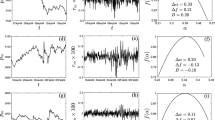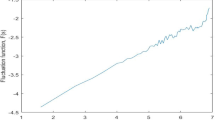Abstract
Daily return series of Dow Jones Industrial Average Index (DJIA) and Shanghai Conposite Index are investigated using spectral analysis methods. The day-of-the-week effect is found in the frequency domain in both stock markets. Time-domain performances of the daily returns are also studied. Although both markets have a clear weekly component in the frequency domain, they show some different behaviors with respect to the day-of-the-week effects.
Similar content being viewed by others
References
Cross F. The behavior of stock returns and the weekend effect[J]. Financial Analysts Journal, 1973, 29(6): 67–69.
French K. Stock returns and the weekend effect [J]. Journal of Financial Economics, 1980, 8(1): 55–69.
Jaffe J and Westerfield R. The week-end effect in common stock returns: the international evidence[J]. Journal of Finance, 1985,40(2): 433–454.
Connolly R. An examination of the robustness of the weekend effect[J]. Journal of Financial and Quantitative Analysts, 1989,24(2): 133–169.
Kamath R and Chakornpipat R. Return distributions and the day-of-the-week effects in the stock exchange of thailand[J]. Journal of Economics and Finance, 1998,22 (2–3): 97–106.
Sias R W and Starks L T. The day-of-the-week anomaly: the role of institutional investors [J]. Financial Analysts Journal, 1995,51(3): 58–66.
Osborne M F M. Brownian motion in the stock market [J]. Operations Research, 1959,7: 145–173.
Dow Jones Industrial Average 30[EB/OL]. http:// www. quotewatch.com/exchanges/dowindu. html
Shanghai Composite Index [DB/OL]. http://quote, stockstar. com/stock/external- history, asp
Wang H. Random Digital Signal Processing [M] Science Press, Bei**g, 1988 (in Chinese).
Wang H. Modern Spectral Estimation [M]. Southeast University Publishing Co., Nan**g 1991 (in Chinese).
Sang H W, Ma T, and Wang S Z. Hurst exponent analysis of financial time series[J]. Journal of Shanghai University, 2001,5(4):269–272.
Ma T, Sang H W, and Wang S Z. Studies on compass rose and discreteness in time series of stock price increments[J]. Journal of Shanghai University, 2001,7 (3): 273–277 (in Chinese).
Author information
Authors and Affiliations
About this article
Cite this article
Li, WH., Wang, SZ. Spectral analysis of stock data series and evidence of day-of-the-week effects. J. of Shanghai Univ. 6, 136–140 (2002). https://doi.org/10.1007/s11741-002-0021-4
Received:
Issue Date:
DOI: https://doi.org/10.1007/s11741-002-0021-4




